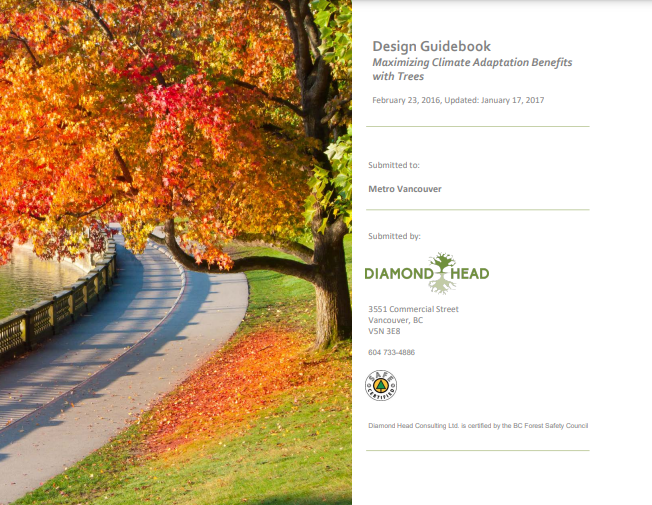Article /
Design Guidebook: Maximizing Climate Adaptation Benefits with Trees

Introduction
This resource was submitted by the Climate Risk Institute for use by the CanAdapt Climate Change Adaptation Community of Practice.
This article is an abridged version of the original text, which can be downloaded from the right-hand column. Please access the original text for more detail, research purposes, full references, or to quote text.
Local governments within Metro Vancouver are already incorporating climate change adaptation into their policies and regulations. As the regional government, Metro Vancouver has a broad interest in ensuring the success of climate adaptation initiatives. \
In Metro Vancouver climate change is projected to result in warmer, drier summers, reduced snow-packs, more frequent extreme rainfall events and rising sea levels. The management of our urban forests is often highlighted as a climate adaptation tool for cities. However, regionally-specific information on how to design tree plantings to maximize climate adaptation benefits has been limited. This guidebook is intended to fulfill that need.
Metro Vancouver’s urban forest consists of all publicly- and privately-owned trees and supporting vegetation in the developed areas of the region. Urban forests provide beneficial services that help cities be more resilient and better adapted to the impacts of climate change: trees and their associated permeable planting areas contribute to climate adaptation by providing shade and cooling, reducing and cleaning stormwater runoff, preventing erosion and sequestering carbon. Twelve priority places across the region—ranging from urban to natural settings—are illustrated to represent the diversity of opportunities to use trees to provide climate adaptation benefits.
This Guidebook has been developed to serve as a quick reference and resource for land managers and member municipalities to support landscape design projects, design guidelines updates and for designing new developments. It can also be used by the development community as a resource guide for best practices in incorporating climate adaptation within development programming and design. This document does not replace or supersede requirements or specifications in zoning bylaws, engineering design standards or Ministry of Transportation requirements.
Each of the twelve priority places is described in terms of:
• Adaptation benefit opportunities;
• Description of typical place context;
• Tree placement options;
• Species selection and planting site design considerations; and
• Recommended targets
Citation: Porter, E., Needoba, A., LeFrancois, C., and Elmore, J. (2017). Design Guidebook: Maximizing Climate Adaptation Benefits with Trees.
